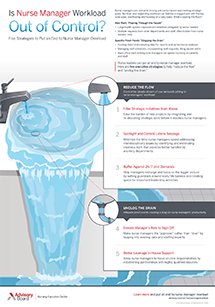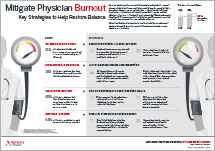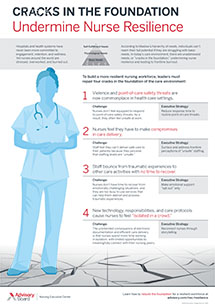Auto logout in seconds.
Continue LogoutAfter experiencing resource scarcity in clinical settings firsthand, hospice nurse Theresa Brown in a CNN opinion piece argues that the health care system should stop encouraging clinicians to "do more with less."
The 4 cracks undermining nurse resilience
The health care 'paradox'
Brown describes what she views as a "paradox" in modern health care: "The clinical space where patient care occurs operates on a model of scarcity, while the back office of CEOs, pharmaceutical companies, and large hospital systems functions in a world of plenty."
She recalls her time working at a hospital that had two or three pulse-ox devices per floor. A pulse-ox is a device that attaches to a patient's finger and detects their oxygen level. "The need for a pulse-ox device becomes extreme in the hospital when a patient who had been stable suddenly gasps for breath and begins to turn blue," Brown explains.
But due to the scarcity of devices, nurses sometimes were forced to "hurry around the floor asking where a pulse-ox device" might be located—an act, she writes, that "compounds the stress and delays care when the patient struggling to breathe cannot wait."
Brown writes that the devices can in some cases cost as little as $20, although others can cost significantly more. "[W]e nurses begged for more, we were always told the money wasn't 'there' in the budget, despite our hospital system's obvious wealth," Brown writes.
She adds that nurses also had to work around broken disposable thermometers and "shot" blood pressure tubing.
"And of course, when nurses were off on maternity leave, or for unpaid personal or family leave under [the Family and Medical Leave Act], or simply because they were ill, it was rare to get a replacement, even though shortages of nursing staff are known to put patients at risk," Brown writes.
But in response to the nurses' pleas for more equipment or staff, they often heard they needed to learn to "do more with less," according to Brown. "This puzzled me and then made me angry, since at some point less becomes only less and can't be turned into more."
What Brown diagnoses as the problem
Brown notes that in 2018 alone, 14 pharmaceutical companies made at least $1 billion in profits. But the problem, Brown argues, is not the profits per se—it's how the profits are spent.
"American health care is swimming in money, but the money benefits systems, companies, and big shot administrators, not patients," she writes. According to Brown, "[A] very long line could likely be drawn from the nickel-and-diming afflicting nurses on hospital floors to the money used to promote Viagra—or any so-called 'blockbuster drug'—combined with its profits."
And she argues that the "the problem of only seeing scarcity in health care comes up in political arguments." For example, she writes, "The most frequent charge leveled against Medicare-for-all proposals is that such programs would be 'too expensive,' but too expensive for whom?"
Brown argues for American households that must choose between buying food or paying for medical care, or those who have declared bankruptcy due in part to medical costs, Medicare-for-all would not be "too expensive."
"We hear 'patients before profits' as a slogan, and that's not wrong, but it's not complete," Brown writes. "Profits are routinely prioritized over pain, over kindness, over nurses and doctors being able to do our jobs. The real scarcity in American health care is not money but compassion" (Brown, CNN, 6/18).
The 4 foundational cracks that are undermining your nurses’ resilience
Hospitals and health systems have never been more committed to engagement, retention, and wellness. Yet nurses around the world are stressed, overworked, and burned out.
Check out our infographic to learn which four cracks in the care environment leaders must repair to rebuild the foundation for a resilient workforce.
Don't miss out on the latest Advisory Board insights
Create your free account to access 1 resource, including the latest research and webinars.
Want access without creating an account?
You have 1 free members-only resource remaining this month.
1 free members-only resources remaining
1 free members-only resources remaining
You've reached your limit of free insights
Become a member to access all of Advisory Board's resources, events, and experts
Never miss out on the latest innovative health care content tailored to you.
Benefits include:
You've reached your limit of free insights
Become a member to access all of Advisory Board's resources, events, and experts
Never miss out on the latest innovative health care content tailored to you.
Benefits include:
This content is available through your Curated Research partnership with Advisory Board. Click on ‘view this resource’ to read the full piece
Email ask@advisory.com to learn more
Click on ‘Become a Member’ to learn about the benefits of a Full-Access partnership with Advisory Board
Never miss out on the latest innovative health care content tailored to you.
Benefits Include:
This is for members only. Learn more.
Click on ‘Become a Member’ to learn about the benefits of a Full-Access partnership with Advisory Board
Never miss out on the latest innovative health care content tailored to you.



